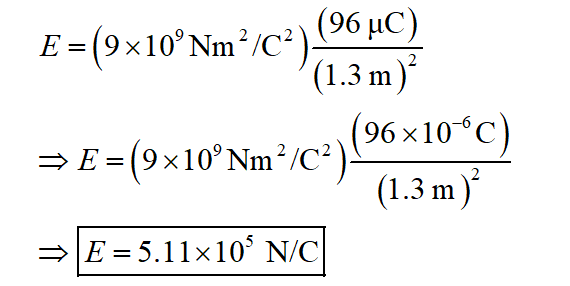a) Find the magnitude of the electric field at (0.5 m, 1.2 m). b) Find the components of the electric field at (0.5 m, 1.2 m). c) Find the magnitude of the electric field at (-1.5 m, 0.8 m).
Please draw as many pictures as possible. Greatly appreciated.
A -96 micro-Coulomb point charge is stuck at (0,0). No other charges are around.
The cosine and sine of the large angle on a triangle with sides 0.5, 1.2, and 1.3 are 0.5/1.3 and 1.2/1.3.
To find components of a vector, you have to draw the vector first. Also, unless it's perfectly horizontal or vertical, you should make a triangle that includes the vector as hypoteneuse and the two components as horizontal/vertical legs. Then do trig.
a) Find the magnitude of the electric field at (0.5 m, 1.2 m).
b) Find the components of the electric field at (0.5 m, 1.2 m).
c) Find the magnitude of the electric field at (-1.5 m, 0.8 m).
d) Find the components of the electric field at (-1.5 m, 0.8 m).
e) Draw a picture that includes the vectors determined in parts b and d, in their respective locations.
f) Now suppose at some instant a +35 micro-Coulomb point charge finds itself at (0.5 m, 1.2 m). What are the components of the electric force acting on this charge?
g) Suppose at some later instant a - 55 micro-Coulomb point charge finds itself at (-1.5 m, 0.8 m). What are the components of the electric force acting on this charge? (The charge in part f is gone now.)
Hello. Since your question has multiple sub-parts, we will solve the first three sub-parts for you. If you want the remaining sub-parts to be solved, then please resubmit the whole question and specify those sub-parts you want us to solve.
a)
The charge’s electric field at (0.5m, 1.2 m) can be found as,

Here, k, q, and r represent the Coulomb’s law constant, the charge’s magnitude, and the charge’s distance from the point, respectively.
The charge’s distance from the point can be determined as,

Here, (x1, y1) and (x2, y2) represents the charge’s coordinate and the point’s coordinates, respectively.

Substitute the relevant values in (1).

Trending now
This is a popular solution!
Step by step
Solved in 3 steps with 17 images









